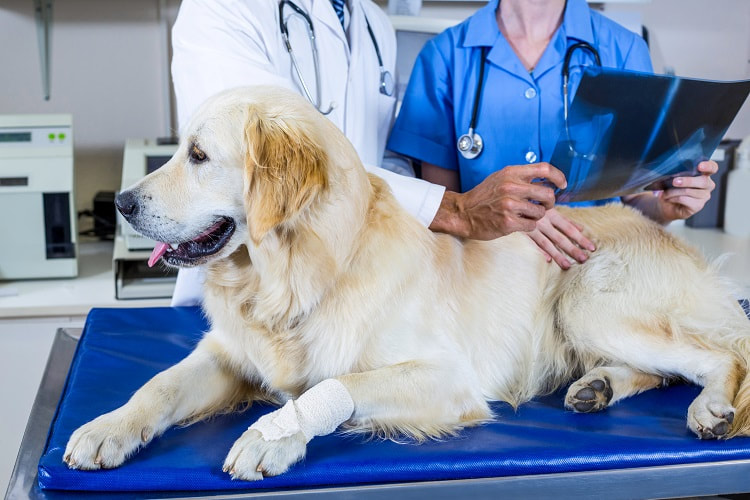|
For animal owners
Hip Dysplasia is a painful condition that causes one or even both hip joints to develop abnormally as the puppy grows. Whilst hip dysplasia is still a common problem among canines, there are some things we can do to help reduce the risk of hip dysplasia as our understanding of the condition has improved over time. In this guide to hip dysplasia in dogs, we discuss in more detail what hip dysplasia is and what dog owners should know. What is Hip Dysplasia?The hip is a “ball and socket” joint that usually fits closely together in order to enable easy movement. Hip dysplasia occurs when this hip joint doesn’t fit together properly and can cause pain, swelling, and even arthritis over time. The ball (the head of the femur, or thighbone) and the socket in the pelvis, also known as the acetabulum, need to grow at equal rates. It is when this is not the case when the deformity occurs. Puppies are not born with hip dysplasia. Whilst the condition can occur relatively young, puppies are in fact born with normal hips and do not have hip dysplasia at birth. This is due to the fact that when puppies are born, their hip joints are cartilage and only become bone as the puppy grows. The process begins shortly after birth if puppies are going to develop the condition and will start showing symptoms which they are about 5-6 months old. Whilst there are no exact rules, the condition tends to be worse in medium or large-breed dogs, dogs that are overweight, and also dogs that have been over-exercised when they were young and growing. Genetic elementsWhilst a lot of the condition and the genetics behind what causes it still remains unknown and environmental factors are important, studies have shown that hip dysplasia is more common in some breeds than others. Whilst this indicates that the condition is in some way genetic, it is challenging for scientists to understand which genes are responsible for the development of the disorder. This is because, whilst some genes are associated with the condition, they are genes that are breed-specific. Therefore the genes that are linked to hip dysplasia are different in different breeds, making the job of scientists extremely difficult. These challenges mean that it is unfortunately unlikely that researchers are going to discover a genetic solution to hip dysplasia that will work across breeds. Whilst genetics have an important role to play, the chance of inheriting the condition is low. Schemes are in place with reputable breeders that check for hip dysplasia before mating two dogs. This can help reduce the risk of the litter developing hip dysplasia. What are the symptoms of Hip Dysplasia?Several symptoms can indicate hip dysplasia. Please note that not all of these symptoms mean it is this condition therefore it is important to visit your vet for an accurate diagnosis. It is also important to note that the condition can occur extremely mildly to begin with, so they may not show any symptoms until the condition has worsened and has led to arthritis.
How is Hip Dysplasia Diagnosed?Your vet will go through your dog’s medical history, check for detached joints, loss of motion, or pain in the hip area. In addition to this blood tests or x rays can also help assess how serious the hip dysplasia in dogs is. What is the treatment?There are several types of treatments that can help improve the condition.
It is important to keep your dog’s weight under control as the extra weight can add unnecessary additional strain on the joint which can cause more pain and worsen the condition. Exercise Whilst exercise can help keep your dogs weight under control, it can also help keep the joint moving. You must keep the exercise controlled though as over-exercise can be harmful. Start with regular, short walks and avoid jumping or chasing unless your vet advises you otherwise. Medication Anti-inflammatory medication or other types of pain relief may be prescribed by your vet Surgery When hip dysplasia is severe in dogs, surgery may be the only option. There are a few options available such as a pelvic Osteotomy, femoral head osteotomy, or total hip replacement. You will need to discuss them with your vet who will be able to advise which one will best suit your dog’s condition. Ongoing care Even if your dog has surgery, you will need to continue treatment throughout the dog’s life in order to keep the condition under control. These additional treatments can help control the pain, improve mobility and improve the dog’s overall quality of life. Joint supplements- these can help slow the development of arthritis Hydrotherapy- the use of water can be a great way to exercise the dog without having to put strain on their joints Physiotherapy- tailored exercises and stretches can help build muscle strength and help take pressure off the hip joints. Most dogs with hip dysplasia end up developing arthritis which can be extremely painful for the dog. If your dog’s pain is severe to the point of not being able to be controlled, then you may need to consider making the difficult decision to put them to sleep. However, your vet will be able to advise whether this is necessary or if there are alternative methods of treatment to try first. Hip dysplasia is, unfortunately, a painful condition that requires lifelong treatment. However, by understanding the condition, knowing what the symptoms are and what forms are treatment are available, dog owners are in the best position to help monitor the condition and help ensure their dog lives a comfortable, long life.
0 Comments
Your comment will be posted after it is approved.
Leave a Reply. |
AuthorNAVP Archives
June 2024
Categories
All
|
The Association |
Services |
|


 RSS Feed
RSS Feed